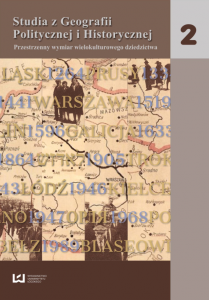Issues of mixed Catholic-Lutheran marriages and conversions on Masuria in years 1850–1960
DOI:
https://doi.org/10.18778/2300-0562.02.09Keywords:
baptism, statistical dates, emigration, protestants, Catholics, conversion, Protestant Church, Catholic Church, priests, mixed marriage, Masuria, cult, weddingAbstract
A church reform introduced in East Prussia in 1525 brought the change of current religious relationships. In place of catholic Church the new Lutheran confession was officially introduced. To the half of the 19th century mixed marriages and mutual conversions have rarely appeared. Only in the 19th century, along with numerical height of the catholic community this problem started appearing more often. Analysis of statistical datas from the end of the 19th age and the 20th beginning are showing that such marriages have more often been contained in the Lutheran Church, and that the children were also being raised mainly in this faith. Also the balance of mutual conversions was advantageous for the Lutheran Church. Therefore in connecting to the roman catholic Church the Lutheran Church did not only lose, but even attracted new faithful.
After the Second World War Lutherans became minority faith. Because of dislike from authorities and intolerance from new catholic settlers, Lutherans tried to avoid mixed marriages. If it already reached them, in general the marriage ceremony and baptism of children took place at the Roman Catholic Church. Sometimes occurred that the Lutherans on Masuria made conversion to Catholic faith right before entering into marriage with the Catholic. To the end of the fiftieth years mixed marriages constituted the little percent contained in both churches of marriage ceremonies. If to add the high birth rate in Masuria families, a statement that the mixed marriages and conversions to Catholicism did not have a direct effect to the demographic situation of the Lutheran Church on Masuria will be entitled. Clearly negative consequences of catholic – Lutheran marriages turned up only at the more late period. Taking the mentioned subject matter was aimed at introducing to the issue of the interrelation the evangelical and catholic community on Masuria. These issues have always aroused great emotions, especially when it was direct confrontation of representatives of both religious groups.
Particularly when containing mixed marriages and associated with them conversions reached situations, in which both Churches accused each other mutually against the proselytism and the religious intolerance. It seems that It was a long-lasting element of the mutual coexistence, evangelicals and Catholics which with special power appeared in the first post-war years. Also in late years the interrelation was not also deprived of difficult and dramatic moments.
References
Belzyt L., 1996, Zur Frage des nationalen Bewußtseins der Masuren im 19 und 20 Jahrhundert (auf der Basis statistischer Angaben), „Zeitschrift für Ostmitteleuropa-Forschung”, 45 (1), s. 35–71.
Google Scholar
Brenda W., b.r.w., Katolicy i katolicyzm na ziemi Piskiej w latach 1525–1945, „Pisz Kulturalnie.pl”: http://piszkulturalnie.pl/z-historii-regionu/pisz/katolicy-i-katolicyzm-na-ziemi-piskiej-w-latach-1525-1945 (08.10.2012 r.).
Google Scholar
Demby R., b.r.w., Olecko. Czasy, ludzie, zdarzenia. Reformacja: www.olecko.info: http://www.olecko.info/index.php?option=com_content&view=article&id=63:reformacja&catid=33:olecko-czasy-ludzie-zdarzenia-&Itemid=174 (09.10.2012 r.)
Google Scholar
Hase C.A., 1879, Herzog Albrecht von Preussen und sein Hofprediger, Wydawnictwo Breitkopf und Hertel, Leipzig.
Google Scholar
Jagucki A., 2001, Burzliwe lata na Mazurach, „Gazeta Ewangelicka”, 5.
Google Scholar
Jasiński G., 2003, Kościół ewangelicki na Mazurach w XIX wieku (1817–1914), Edycja wspólna Towarzystwa Naukowego i Ośrodka Badań Naukowych im. Wojciecha Kętrzyńskiego, Olsztyn.
Google Scholar
Kalendarze Ewangelickie z lat: 1956, 1958, 1962 i 1966.
Google Scholar
Kossert A., 1987, Między dwiema tradycjami. Trudna historia Kościoła ewangelickiego na Mazurach po roku 1945, „Borussia”, 17.
Google Scholar
Koyorć L., 1957, Mazury odbrązowione. Kraina dysydentów polskich, [w:] Kalendarz ewangelicki, Warszawa.
Google Scholar
Kruk E. (red.), 2001, Ewangelicy na Warmii i Mazurach. Dzieje i współczesność, Wydawnictwo Mazurskiego Towarzystwa Ewangelickiego, Olsztyn.
Google Scholar
Neumeyer H., 1977, Kirchengeschichte von Danzig und Westpreußen in evangelischer Sicht, verlag Gerhard Rautenberg, Leer.
Google Scholar
Oldenberg F.S., 2000, Przyczynki do poznania Mazur, Wydawnictwo Naukowe Semper, Warszawa.
Google Scholar
Sakson A., 1990, Mazurzy – społeczność pogranicza, Instytut Zachodni, Poznań.
Google Scholar
Downloads
Published
How to Cite
Issue
Section
License

This work is licensed under a Creative Commons Attribution-NonCommercial-NoDerivatives 4.0 International License.








